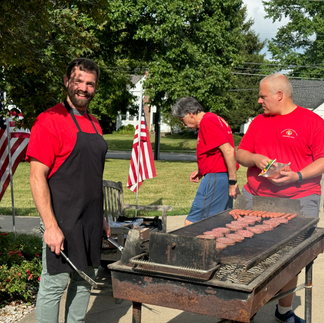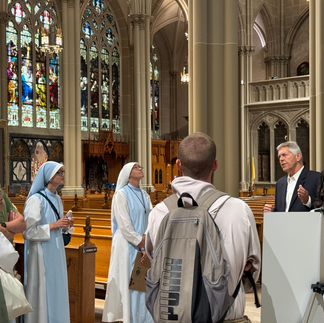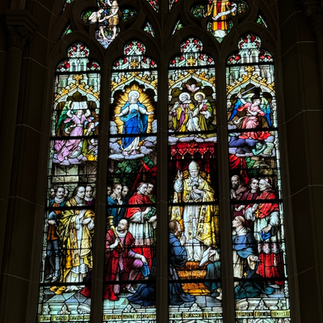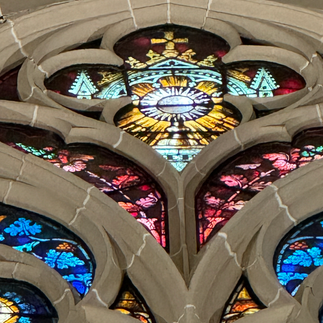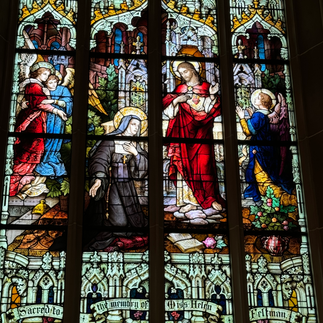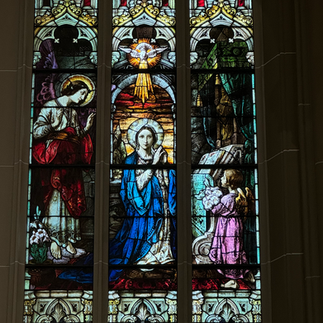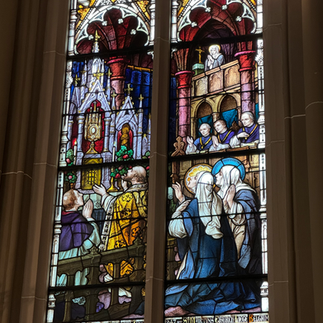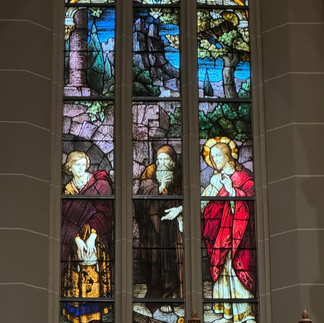Day 48 — A Pilgrimage to the Cathedral Basilica of the Assumption in Covington
- SetonPilgrimage24
- Jul 4, 2024
- 5 min read
MADEIRA, OHIO, July 4 — Because of the nature of the celebration of Independence Day in the United States, the Seton Route pilgrims of the National Eucharistic Pilgrimage had a day without scheduled activities.
They took advantage of the opportunity to head across the Ohio River to the Cathedral Basilica of the Assumption in Covington, Kentucky, one of the United States' most beautiful Churches. The exterior of the French Gothic cathedral is built according to the model of Notre Dame in Paris and the interior according to Saint Denis in Paris. Pilgrims were appropriately stunned by the beauty of its architecture, art, wood sculpting, and especially its stained glass windows.
The Cathedral was scheduled to close for the national holiday after the 9:00 am Mass, but the rector of the Cathedral, Father Ryan Maher, generously kept the Cathedral open for the pilgrims for a semi-private Mass, a guided tour by docent Michael Sterling and then a Eucharistic holy hour.
Their visit began with Mass celebrated in the Blessed Sacrament Chapel by Seton Route chaplain Father Joseph Michael Fino, CFR. Father Roger Landry concelebrated the Mass and preached the homily.
Father Landry began by focusing on how Independence Day naturally leads us to think about freedom, which must be won anew by every generation. For Christians, freedom is never merely "freedom from" but always also "freedom for." As St. Paul writes in his Letter to the Galatians, "For freedom, Christ has set us free." We must use our freedom from sin that he gained for us, freedom in the truth that liberates us, ultimately for the gift of self in love.
The first proper use of that freedom, Father Landry said, is in the Gospel reading in the example of the friends who brought their paralyzed chum to meet Jesus. They had faith in Jesus' power to heal him and had the love for their friend to overcome the obstacle of a mob scene at the door to climb up on the roof and lower him literally right on top of Jesus. Our freedom is meant to be used to choose to come into God's presence and to love others enough to bring them into that same presence, Landry said.
In healing the paralyzed man's sins before healing him of his paralysis, Jesus showed the use of his freedom to bestow the mercy he had come into the world to give. As the Alleluia verse from St. Paul's words to the Corinthians testify, "God was reconciling the world to himself in Christ and entrusting to us the message of reconciliation." Pope Francis said a decade ago that everything Jesus did — healing, teaching, feeding, exorcising, raising from the dead — was just a sign of what his ultimate aim was, to bring back into communion all of us to the Father. He came to reconcile through his merciful. That's his ultimate goal in the Holy Eucharist as well, not just to be with us and to feed us, but to bring us into communion with the Blessed Trinity and with each other. HIs body and blood were shed "for the remission of sins" and to make us one body, one spirit in Christ.
He also sought, Father Landry continued, to make us missionaries of this reconciliation to others. That's a call all have received, not just priests and religious. In the first reading, we see that Amos wasn't a professional prophet or of a priestly tribe, but was a farmer — a shepherd and a dresser of sycamore trees. He was a layman. And yet God called him from Tekoa, 10 miles south of Jerusalem, in the Kingdom of Judah to go to the Kingdom of Israel in the north and preach a message of conversion to the king, the priestly class and all the people. We all have a similar mission.
Landry finished with two examples of those who lived out that mission well, both remembered liturgically on July 4.
The first is St. Elizabeth of Portugal, who was a daily Massgoer who lived out her life trying to reconcile and convert her unfaithful husband not to mention many were were causing division in the royal family as well as in the kingdom. She likewise tried to help the poor, the sick, the homeless, the orphans and others to come to recognize their dignity and live by it.
The second was Blessed Pier Giorgio Frassati, the confirmation patron of pilgrim Dominic Carstens, who was a daily Mass goer and nocturnal adorer whose Eucharistic piety translated similarly to care for the poor, the sick, and the needy.
Both, said Landry, used their freedom to love as Christ loved them on Calvary and loves them in the Eucharist. Both, together with the friends of the paralyzed man and the prophet Amos, show us a beautiful use of freedom in collaborating with Jesus' work in the Eucharist, in the Sacrament of Penance and through the Church, lovingly to gather into one all those whom he created and for whom he died.
After Mass, pilgrims received a 45 minute guided tour by Cathedral docent Michael Sterling. He described the history of the Basilica, introduced us to the stunning lower level stained glass images,
After Mass, they were able to have a Holy Hour in the Blessed Sacrament Chapel, which featured beautiful murals on the Emmaus Scene, the Crucifixion, the Old Covenant temple sacrifices by the High Priest, and on Christ's blessing us in the Eucharist. It also contains stained glass windows of the first Euucharistic Congress, 1895, in Washington DC at St. Patrick's Church (which the Seton pilgrims visited on June 7), on the First local feast of Corpus Christi in Liege, Belgium in 1247,, on the Passover scene, on God's giving the Israelites manna and water in the desert, and on Melchizedek's Sacrifice.
They were permitted to use an extraordinary gold monstrance for adoration and benediction that is part of the treasury of the Basilica. During the Holy Hour, Father Joseph Michael preached a meditation on how to go more deeply in contemplative prayer during Eucharistic adoration as Jesus attempts to grab us by the heart.
After Mass, pilgrims had the remainder of the day to rest and recuperate. They cooked themselves a meal at the place where some of the pilgrims are staying, shared some original poems, music and stories, and prayed together.
In the evening, they had a cookout prepared by the local Knights of Columbus, which they ate with the Dominican priests and brothers of St. Gertrude, the Knights, a host family and some CFR sisters from Harlem, who happened to be in town.



